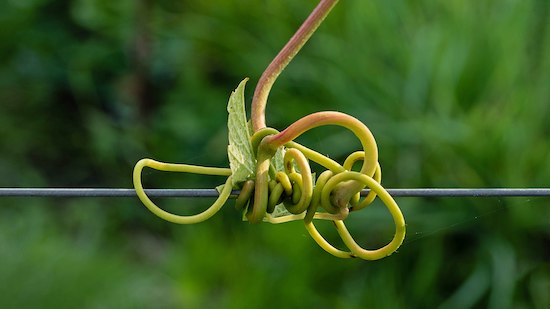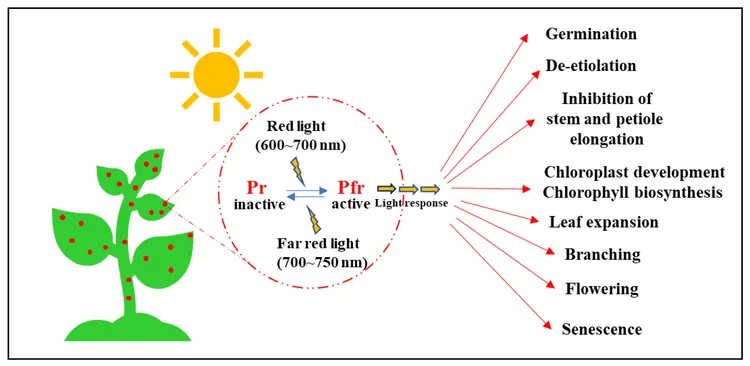Plant Responses to Stimuli
As introduced earlier, tropism is a phenomenon that describes a plant’s tendency to curve towards or against a stimulus. Tropisms that direct the plant to grow toward a stimulus are known as positive tropism and those away from the stimulus as negative tropism.
Sources of Stimulus
We mentioned that the response to light is called phototropism but there are also other sources of stimulus. Gravitropism is the directional growth response of a plant to gravity. This explains how a shoot from seed will always go upward regardless of the seed’s position when it germinates on the ground.
One hypothesis on how plants tell up from down is that gravity pulls special organelles containing dense starch grains to the low points of cells and this uneven distribution of organelles signals the cells to redistribute auxins.
Thigmotropism is the growth response to touch, which is different from thigmonastism shown by the Makahiya plant where there is rapid movement due to touch. Thigmotropism can be observed on climbing plants where you might see their tendrils coil around certain objects, say a wire.

All these tropisms help plants stay in tune with their environment.
Plant’s “Biological Clock”
Plants also have other means of tracking and keeping time with the environment. You might have observed how some plants fold their leaves or flowers in the evening and unfold them in the morning. Think of it as if the plant is “sleeping”. Much like animals, plants also have a circadian rhythm, the innate biological cycle not controlled by any known environmental variable.
Research on a variety of organisms indicates that circadian rhythms are controlled by internal timekeepers known as biological clocks. We know in humans that our biological clock is stored in nerve cells in our hypothalamus but we do not know about plants and also other organisms. One hypothesis is that timekeeping in plants involves “clock genes”.
A biological clock must not only be able to detect daily events but the influence of seasonal events. The environmental stimulus plants often use to detect the time of year is called photoperiod, the relative lengths of day and night.
Plants whose flowering is triggered by photoperiod fall into two groups: (1) short-day plants are those that generally flower in late summer, fall, or winter when days are shorter while (2) long-day plants usually flower in late spring or early summer when days are longer.
Research in this field actually led to the observation that responses to photoperiods are actually controlled by the length of continuous darkness rather than the length of daylight. So how does a plant measure photoperiod? Answer: Phytochromes.
Proteins with light-absorbing components, phytochromes can detect different wavelengths of light. Phytochromes in plants come in two forms. One form, phytochrome red (Pr), absorbs red light and is quickly converted to the other form phytochrome far-red (Pfr), which then absorbs far-red light and converts back to Pr form.
This interconversion between the two controls the various light-induced events in plants. Each night Pr molecules are synthesized and accumulate and when dawn breaks, the red wavelengths of sunlight convert much of the Pr to Pfr. And although the sun’s rays also have far-red light wavelengths, it is much faster to convert Pr to Pfr than the other way around.
Put in another way, the ratio of Pfr is higher than Pr and this sudden increase of Pfr at dawn resets the plant’s biological clock.

Plant Defenses
Not only must plants respond to environmental stimuli, they too must interact with other organisms. We have mentioned mycorrhizae before but what about those that feed on plants? Those that infect plants? How does the plant take care of itself?
Because herbivores feed on plants, the latter can employ three types of defenses:
- Physical defenses such as thorns and spines;
- Chemical defenses such as distasteful or toxic compounds; and
- Chemicals that recruit other animals that kill the herbivore.
A plant’s first line of defense against pathogens is also the epidermis, but some microbes can cross this barrier, much like in us humans.
Once invaded by a pathogen, plants respond with chemicals that act as a second line of defense. Some of these chemicals toughen the cell walls to slow the pathogen, others cause plant cells at the infected site to destroy themselves and before a plant cell gets killed, they release microbe-killing chemicals that signal nearby cells to mount similar chemical defenses.
Next topic: The Principles of Ecology
Previous topic: Plant Hormones
Return to the main article: Plant Form and Functions
Download Article in PDF Format
Test Yourself!
1. Practice Questions [PDF Download]
2. Answer Key [PDF Download]
Copyright Notice
All materials contained on this site are protected by the Republic of the Philippines copyright law and may not be reproduced, distributed, transmitted, displayed, published, or broadcast without the prior written permission of filipiknow.net or in the case of third party materials, the owner of that content. You may not alter or remove any trademark, copyright, or other notice from copies of the content. Be warned that we have already reported and helped terminate several websites and YouTube channels for blatantly stealing our content. If you wish to use filipiknow.net content for commercial purposes, such as for content syndication, etc., please contact us at legal(at)filipiknow(dot)net